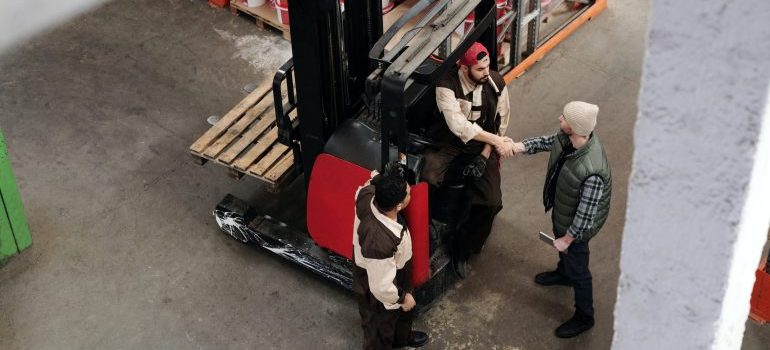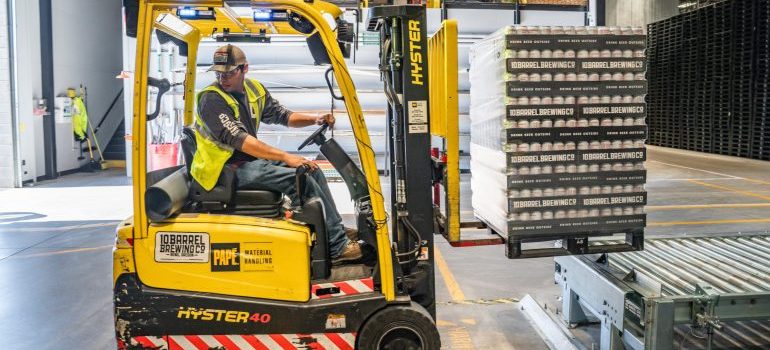A Beginner’s Guide to Heavy Equipment Transport Process
Heavy equipment transport is a crucial process for industries that deal with large and heavy machinery. It involves moving equipment such as construction machinery, mining equipment, and agricultural machinery from one location to another. Due to the size and weight of these machines, regular vehicles cannot transport them, and specialized equipment and careful planning are required for a safe and efficient move. Hansen Bros. Moving & Storage WA provides this beginner’s guide to the heavy equipment transport process which aims to provide an overview of the process, including the planning and preparation phase, loading and securing, transportation, and unloading.
Planning for Heavy Equipment Transport
When planning for heavy equipment transport, there are several critical factors to consider to ensure a successful move. The weight and dimensions of the equipment must be assessed. This will impact the choice of transportation method and equipment required. The route taken must also be carefully planned, taking into account any obstacles or restrictions, such as low bridges or narrow roads.
In addition to these factors, there are various permitting and regulatory requirements that heavy equipment movers must meet when transporting heavy machinery. This can include obtaining permits for oversize or overweight loads, complying with state and federal regulations, and ensuring that the transport company has the necessary licenses and insurance coverage.

Choosing the right transport company is also a crucial part of the planning process. It is essential to select a reputable company with experience handling heavy equipment and can provide the necessary equipment and personnel to ensure a safe and efficient move. It is recommended to do research, check references, and compare prices before making a final decision.
Preparing Heavy Equipment for Transport
Properly preparing heavy equipment for transport is crucial for a safe and successful move. Best practices include securing loose parts, such as doors and hatches, and removing attachments to reduce the overall size and weight of the equipment. The equipment must also be perfectly clean in order to prevent debris from falling off during transport.
Loading and unloading heavy equipment requires specialized equipment and trained personnel. The equipment must be loaded and secured onto the transport vehicle using appropriate rigging and tie-downs. It must also be properly positioned to distribute weight evenly, ensuring the safety of the equipment and those involved in the move.
Safety considerations are paramount when preparing heavy equipment for transport. It is essential to ensure that the equipment is stable and secure, minimizing the risk of accidents or damage during transport. Additionally, it is crucial to follow all safety guidelines and regulations, including wearing appropriate personal protective equipment.
For those seeking assistance with heavy equipment transport, moving services Seattle offers are a reliable option. They have extensive experience handling heavy machinery and adhere to rigorous safety guidelines to ensure a successful move. Their trained personnel utilize specialized equipment to load and secure equipment safely onto transport vehicles. It’s important to consider a company’s experience, safety record, and expertise in heavy equipment transport when selecting a transport provider, and moving services Seattle ticks all the boxes.
Types of Heavy Equipment Transport Process
There are several types of heavy equipment transport to consider, each with its advantages and disadvantages. Open trailers are the most common and cost-effective option, but they do not provide protection from the elements and can expose the equipment to road debris. Flatbeds offer better protection and can accommodate a wider range of equipment, but they may not be suitable for equipment with irregular dimensions or unusual shapes. Lowboys are the most versatile option, as they can handle oversized and overweight equipment, but they are also the most expensive and require additional permits.

When selecting the right type of transport for your needs, it is essential to consider the size, weight, and dimensions of the equipment being transported. It is also important to consider the distance of the move and any specific requirements, such as permits or regulatory compliance.
When it comes to selecting a transport provider for heavy equipment, it’s essential to do your research and compare options. Some companies offer specialized heavy equipment transport services that can cater to your specific needs. Look for companies with experience and expertise in handling heavy machinery and following safety guidelines and regulations. Additionally, it’s a good idea to check references and compare prices to find a reliable and affordable option that suits your transportation requirements.
Heavy Equipment Transport Costs
The cost of heavy equipment transport can vary depending on several factors, including the distance to be covered and the type of equipment being transported. Other factors that can affect the cost include the type of transport and any necessary permits or regulatory compliance. Consolidating shipments and negotiating rates can help reduce the cost of heavy equipment transport.
When transporting heavy equipment, insurance and liability considerations are also important. It’s important to understand the level of coverage provided by the transport company and to consider additional insurance options if necessary. Liability considerations should also be taken into account, especially if the equipment being transported is particularly valuable or fragile. Carefully consider these factors and work with reputable and experienced transport providers, so you can ensure successful and cost-effective heavy equipment transport.

Safety Considerations
Ensuring safety during heavy equipment transport is crucial to avoid accidents and protect everyone involved. Safety considerations include weight limits, road conditions, and compliance with safety regulations. Transport teams should also follow best practices to ensure the safety of equipment and other drivers on the road.
To ensure safety during heavy equipment transport, it is important to properly secure and distribute the weight of the equipment being transported. Drivers should be aware of weight limits and restrictions on certain roads and bridges, and take alternate routes if necessary. Other safety considerations include proper lighting and signage on the transport vehicle, as well as checking and maintaining equipment regularly.
Regulations and requirements for heavy equipment transport also exist to ensure safety. These may include specific permits or escort vehicles for oversized loads and compliance with regulations related to driver hours and rest breaks. It is important to work with a reputable transport provider that has experience and knowledge of these regulations and requirements. This is done in order to ensure compliance and safety during the transport process.
Common Challenges in Heavy Equipment Transport
When it comes to heavy equipment transport, there are several common challenges that may arise during the process. One challenge is ensuring that the equipment is properly secured and protected during transport to avoid damage or accidents. This requires specialized knowledge and equipment, which not all transport companies may have.
Another challenge is navigating through difficult terrain or inclement weather conditions, which can impact the safety and efficiency of the transport process. In these situations, it is important to work with a transport company that has experience in navigating challenging conditions, such as the shipping companies Seattle has to offer.
Logistical challenges can also arise. Coordinating transport schedules and ensuring that permits and regulations are properly obtained and followed is one of them. To navigate these challenges, it can be helpful to work with a broker or shipping company. Make sure they have experience in managing the logistical aspects of heavy equipment transport.

By working with an experienced and knowledgeable transport company in Seattle, you can address these common challenges and ensure a successful heavy equipment transport process.
Maintenance and Repairs
To ensure that heavy equipment remains in good condition during transport, it’s crucial to perform maintenance and repairs as needed. One effective way to protect equipment is to use shipping crates Seatle has to offer. These crates minimize the risk of damage from impacts and vibrations.
Regular equipment inspections are also important. This includes checks for loose parts or attachments, adjustments to tire pressure, and lubrication of moving parts. Having a plan in place for addressing issues that may arise during transport, such as breakdowns or malfunctions, can help minimize the risk of damage.
By taking these steps, heavy equipment can be safely transported to its destination. Working with an experienced shipping company in Seattle that has expertise in heavy equipment transport and maintenance can help ensure a successful transport process.
Training and Certification for Heavy Equipment Transport Personnel
The safe and successful transport of heavy equipment depends not only on the equipment itself. It also depends on the knowledge and skill of the personnel handling it. To ensure that personnel is qualified to transport heavy equipment, training, and certification programs are available.
Training programs cover a range of topics, including equipment operation, load securement, and safety regulations. Certification programs typically require the completion of a training program, passing an exam, and ongoing education to maintain certification.
Having properly trained and certified personnel is essential for maintaining safety during heavy equipment transport. Personnel who are knowledgeable about proper load securement, weight distribution, and other critical factors can help minimize the risk of accidents and damage to equipment.

When selecting a reputable shipping company in Seattle for heavy equipment transport, it’s important to inquire about their personnel training and certification programs. Picking a company with qualified and experienced personnel can help ensure a smooth and successful transport process.
Choosing the Right Transport Route: Tips and Considerations
Choosing the right route for heavy equipment transport is crucial for ensuring a safe and efficient move. Some important tips and considerations when selecting a route include:
- Consider the weight and dimensions of the equipment. Certain roads or bridges may have weight or height restrictions that limit the routes available for heavy equipment transport. It’s important to plan the route carefully. This helps avoid any obstacles or restrictions that could cause delays or damage to the equipment.
- Check for road conditions. When selecting a transport route, the company should be familiar with the condition of the road, including any hills or sharp turns. It’s important to choose a route that is suitable for the type of equipment being transported and if Seattle storage needs to be used.
- Consider traffic and congestion. Heavy equipment transport requires extra space on the road, which can create traffic and congestion. Choosing a route that avoids heavily populated areas or rush hour traffic can help minimize delays and improve safety.
- Research permits and regulations. Many cities and states require permits for heavy equipment transport, and regulations may vary depending on the type of equipment being transported. It’s important to research the necessary permits and regulations before selecting a route.
Working with an experienced shipping company can help ensure that movers are using the right route for heavy equipment transport. They can provide guidance on the best route to take. They can also obtain necessary permits, and ensure that by following all regulations they can minimize the risk of delays or damage to equipment.

Key points to consider
Heavy equipment transport requires careful planning and execution to ensure a successful move. Select the right transport company, prepare the equipment properly, choose the right transport route, and prioritize safety at all times. When selecting a transport provider, it’s important to consider their experience, safety record, and level of expertise in heavy equipment transport.
Working with a reputable company can provide the peace of mind and guidance necessary to ensure a successful move. It’s also essential to follow best practices for heavy equipment transport. They include preparing the equipment properly, selecting the right transport route, and prioritizing safety at all times. With these considerations in mind, you can feel confident in your ability to conduct a successful heavy equipment transport process.
Why Choose Us
History
Hansen Bros. Moving & Storage is locally owned and operated by the same family for four generations, since 1890. We have a well-established reputation for service quality and reliability with a high percentage of repeat household and commercial clients.
Professionalism
We’re a certified ProMover by the American Moving and Storage Association with A+ rating with the Better Business Bureau, voted “Best in Western Washington” in 2009 and from 2011 to 2016 by KING5. Our company is fully licensed and insured and member of WMC and AMSA.
Value
Hansen Bros. Moving & Storage provide free, no-obligation in-home estimate and competitive rates, including low minimum rates for shipments moving under 300 miles. We’ve set a refund policy for unused packing materials and three Puget Sound locations to help clients save on travel fee costs.



